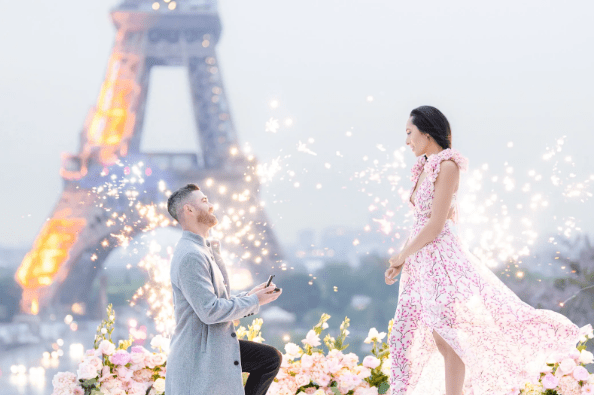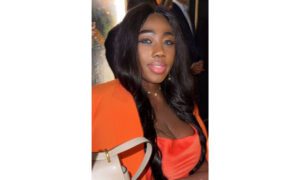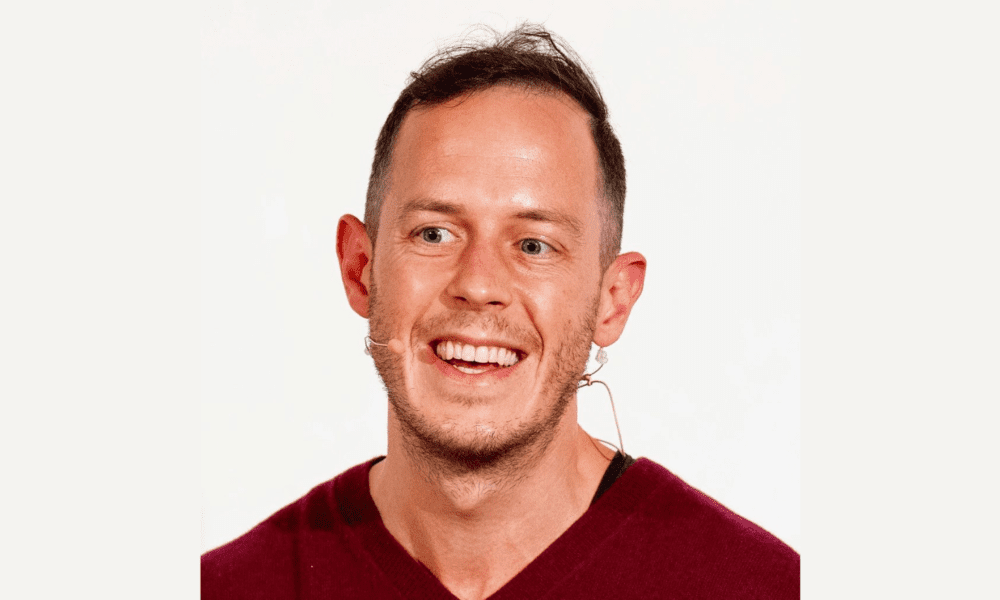How to Plan an Affordable Paris Proposal in Public Locations (Without Sacrificing Quality)
Why Public Locations Work Well for Paris Proposals
After planning and photographing over 1,200 marriage proposals in Paris, we’ve learned that some of the most memorable engagements happen at free public locations with breathtaking Eiffel Tower views—not palace rooftops or private yachts.
Public spots offer iconic Parisian backdrops without venue fees. Your investment goes toward what actually matters: a skilled photographer who knows the location intimately, optional enhancements like a musician or champagne, and the proposal itself.
The trade-off is straightforward. Public locations mean shared spaces—you’ll have joggers, tourists, and locals in the background. Timing becomes critical. Coordination with your photographer matters more than at private venues. But for men working with entry-level budgets, or those who prefer organic Parisian atmosphere over controlled exclusivity, public spots deliver exceptional results when executed correctly.
Public vs. Private Venue Decision Framework
When you’re proposing in Paris, you’re choosing between two fundamentally different approaches:
Public locations are free of charge. You select your spot, arrive with a photographer (and optional musician, roses, champagne), and propose in a shared space. Setup is minimal—park guards will stop anything larger than a small bouquet or battery-powered candle. You’re working around crowds unless you arrive at sunrise or late evening. But the Eiffel Tower views from spots like Trocadéro or Bir-Hakeim Bridge rival what you’d see from expensive private terraces.
Private venues include residential and commercial rooftop terraces, châteaux, Seine yachts, period ballrooms, and palace hotel spaces. These require access arrangements, often command fees ranging from €500 to €5,000+, and need coordination for permits, insurance, and vendor management. They offer controlled privacy and exclusive access, but at substantially higher cost.
Your decision depends on four factors: budget constraints, how much privacy matters, whether an Eiffel Tower backdrop is essential, and your comfort level with shared spaces.
For this guide, we’re focusing on public locations—specifically what works, what doesn’t, and how to execute proposals that look intentional rather than improvised.
Eiffel Tower Public Spots vs. Non-Tower Locations
Not all public spots in Paris are created equal. The primary distinction is whether your backdrop includes the Eiffel Tower. To help couples understand these differences more clearly, many photographers recommend reviewing detailed comparisons before choosing a final spot. You can See detailed comparisons of Paris proposal locations to understand how each location performs at different times of day.
Eiffel Tower public locations include Trocadéro, Bir-Hakeim Bridge, Seine riverbanks near the Tower, and Avenue de Camoëns. These spots deliver the iconic Parisian proposal visual most people envision. The Tower’s presence creates instant context—she’ll immediately understand why you chose Paris for this occasion.
Non-Tower public locations include Tuileries Gardens, the Louvre courtyard, Luxembourg Gardens (specifically Medici Fountain), Pont des Arts, and Montmartre below Sacré-Cœur. These spots offer different aesthetic qualities—classical French gardens, palatial architecture, artistic neighbourhoods—but without the Eiffel Tower as your backdrop.
Neither is better. The right choice depends on what she responds to visually and what you want the photos to convey. Some women specifically want the Eiffel Tower in their engagement photos. Others prefer something less expected.
Eiffel Tower Public Spots: What Works and When
Trocadéro
Trocadéro offers the most direct, elevated Eiffel Tower view available at a public location. The plaza sits across the Seine from the Tower, providing unobstructed sightlines and tiered levels that photographers use for composition variety.
Timing requirements: Trocadéro only works at sunrise—typically 6:00-7:30 AM depending on season. By 8:00 AM, tour buses arrive and the plaza fills with hundreds of tourists. At sunset (the time Instagram oversells), you’re sharing the space with street vendors, tour groups, and pickpockets. The visual may be stunning, but the experience is chaotic.
Sunrise Trocadéro means waking up at 5:30 AM and traveling to the site in darkness. But you’ll have 45-90 minutes of relative quiet before crowds arrive. Your photographer can position you precisely, and your partner won’t be distracted by people filming your proposal on their phones.
Coordination specifics: Your photographer needs your exact arrival time and method (car, metro, taxi). They’ll scout the best platform level based on morning light and existing people on-site. You’ll use WhatsApp with live location sharing so they can guide you to the exact spot. Many photographers use a recognition signal—a specific colored jacket or held item—so you can identify them without verbal confirmation that might alert your partner.
Bir-Hakeim Bridge
Bir-Hakeim is the double-deck bridge featured in Inception and countless Paris engagement photos. The lower pedestrian level offers framed Eiffel Tower views through the bridge’s iron architecture, creating a more intimate scale than Trocadéro’s wide-open plaza.
Timing flexibility: Bir-Hakeim works at sunrise and late evening (9:00-10:30 PM in summer, 6:00-7:30 PM in winter). The bridge stays relatively walkable throughout the day, but mid-afternoon brings steady foot traffic that disrupts photos. Evening proposals benefit from the Tower’s hourly sparkling lights—time your proposal for :55 to :05 of any hour to capture the five-minute light show.
The bridge’s covered structure provides weather protection that open plazas don’t offer, making it more reliable if forecast calls for light rain.
Setup considerations: Bir-Hakeim has multiple proposal spots along its length. The center sections offer the most direct Tower views but get more foot traffic. The western end provides slightly angled Tower views with more privacy. Your photographer will recommend based on time of day and current conditions.
Avenue de Camoëns
Avenue de Camoëns is a residential street with a small park that provides close-range Eiffel Tower views without the crowds of Trocadéro. It’s less known to tourists but familiar to local proposal photographers.
Timing requirements: Sunrise only—this location becomes a neighborhood walking route by 8:30 AM with residents heading to metro stops and walking dogs. The park’s scale is small, meaning even a dozen people make it feel crowded.
The advantage: you’re proposing in an authentic Parisian neighborhood setting rather than a tourist plaza. The Tower looms larger and closer than at Trocadéro, creating different visual composition.
H3: Seine Riverbanks Near the Tower
The pedestrian paths along the Seine—particularly between Pont d’Iéna and Bir-Hakeim—offer ground-level Tower views with the river in your foreground. These work well when combined with a walking proposal approach rather than a stationary setup.
Timing flexibility: These paths are usable throughout the day, but optimal times are early morning (7:00-9:00 AM) and evening (7:00-9:00 PM in summer). Mid-afternoon brings joggers, cyclists, and tourists walking between landmarks.
Seine riverbank proposals work well when integrated into a “couple photo shoot” concept—you’re already walking and taking photos when you stop at a pre-determined spot and propose. This approach feels less staged than arriving at an empty plaza with a photographer already positioned.
Non-Eiffel Tower Public Spots: Different Aesthetic, Different Timing
Louvre Courtyard
The Louvre’s glass pyramid provides architectural drama and symmetry that photographs distinctively. Early morning light creates reflections in the pyramid’s glass that don’t appear later in the day.
Timing requirements: Sunrise only—the courtyard opens to tourists by 9:00 AM and becomes unmanageable for private proposals. Security presence is high, and guards will approach if you’re setting up anything beyond standing and taking photos.
The Louvre works for men who want classical French architecture without the Eiffel Tower dominating the composition. It signals Paris without being obvious.
H3: Tuileries Gardens
Tuileries offers tree-lined paths, fountain areas, and lawn sections that create softer, more romantic visuals than architectural landmarks. The gardens’ scale means you can find relatively private pockets even when other areas have visitors.
Timing flexibility: Tuileries works across most of the day—sunrise for maximum privacy, late afternoon for golden light through the trees, evening in summer for lingering daylight. Avoid midday when tourists pack the central fountain area.
Photographers familiar with Tuileries know which garden sections stay quieter and which angles avoid background distractions. The gardens’ versatility makes them reliable when other locations have unexpected crowds or construction.
Luxembourg Gardens (Medici Fountain)
Medici Fountain is a Renaissance-style fountain in a quiet, tree-canopied section of Luxembourg Gardens. It’s one of Paris’s most photogenic spots that remains relatively unknown to casual tourists.
Timing requirements: Early morning or late afternoon. The fountain area is small and fills quickly when groups arrive. Mid-afternoon often brings students from nearby universities studying on the benches.
Medici Fountain appeals to women who prefer intimate, garden settings over grand architectural statements. It’s romantic without being grandiose.
Pont des Arts and Montmartre
Pont des Arts (the pedestrian bridge with historic love lock associations) offers Seine views with Left Bank architecture. It’s walkable throughout the day but best at sunrise or late evening to avoid bridge traffic.
Montmartre (specifically the steps and plaza below Sacré-Cœur) provides elevated Paris views with the basilica’s white domes as your backdrop. This location works at sunrise—by mid-morning, the area swarms with portrait artists, street performers, and tour groups.
Both locations work well for couples drawn to Paris’s artistic and bohemian history rather than its monumental architecture. If you want a broader perspective on how these artistic spots compare to Eiffel Tower locations, you can Read our complete Paris proposal planning guide for deeper insights.
Why Timing Makes or Breaks Public Spot Proposals
In public locations, timing isn’t about convenience—it’s about viability. The difference between a proposal at Trocadéro at 7:00 AM versus 9:00 AM is the difference between you two with a photographer versus you two surrounded by 200 tourists.
Seconds sometimes matter. If you arrive at Bir-Hakeim at :58 past the hour intending to propose during the Tower’s sparkling lights, but spend three minutes positioning yourselves, you’ve missed the light show and must wait another 55 minutes. Your photographer’s experience with timing and positioning is what prevents these issues.
Sunrise proposals require commitment: You’re waking up at 5:30 or 6:00 AM, traveling to the location in darkness, and proposing before most of Paris is awake. This feels demanding—until you see the results. Sunrise light is softer and more flattering than harsh midday sun. Locations are nearly empty. Your partner isn’t distracted by crowds or vendors approaching you.
The coordination challenge is real: your photographer must be on-site early, you must arrive precisely when planned, and your timing windows are narrow. But photographers who specialize in Paris proposals manage these logistics repeatedly. Your role is following their guidance exactly.
Coordination Strategies for Public Location Proposals
Public spot proposals succeed or fail based on coordination precision. You, your partner, and your photographer are converging at a specific location at a specific time—often when your partner doesn’t know a proposal is happening.
WhatsApp with live location sharing is essential. Your photographer tracks your approach in real-time, confirming you’re heading to the correct meeting point. If you’re coming from a hotel and your taxi takes a different route, they know and can adjust positioning.
Recognition signals prevent awkward searching. Your photographer might specify “I’ll be wearing a red jacket near the fountain” or “I’ll have a brown camera bag on the second tier.” You can identify them without obvious interaction that would alert your partner.
Pre-arrival scouting by your photographer determines exact positioning. They assess current crowds, morning light angles, and any unexpected variables (construction, events, closed sections). They text you updates: “Head to the left side platform, right side is crowded with a tour group.”
Backup timing matters for proposals timed to Tower sparkling lights or specific sunrise conditions. If you’re running five minutes late, your photographer knows whether to hold the original plan or adjust.
This level of coordination is why public spot proposals typically work best with photographers who have local expertise and have executed proposals at your specific location multiple times. You’re not just hiring someone to take photos—you’re hiring someone who can navigate variables you won’t anticipate.
Two Proposal Approaches: Total Surprise vs. Photo Shoot Integration
Public location proposals can be executed as total surprises or integrated into a known “couple photo shoot” where she’s aware photos are happening but unaware you’re planning to propose.
Total surprise approach: She believes you’re heading to Trocadéro for sunrise views or taking a morning walk near Bir-Hakeim Bridge. Your photographer is already positioned. You lead her to a specific spot, often with the photographer appearing to be a random tourist. You propose, the photographer captures it, and only after does she realize the photos were planned.
This approach requires precise positioning and timing. Your photographer needs clear signals about when you’re ready (specific hand positions, turning directions, movements). The surprise element is maximized, but the coordination complexity is higher.
Photo shoot integration: You’ve told her “I arranged for a couple photo shoot in Paris at sunrise”—she dresses up, expects a photographer, and anticipates professional photos. During the shoot, at a location and time you’ve pre-coordinated with the photographer, you propose.
This approach reduces coordination pressure. She’s already expecting a photographer and prepared for photos. The surprise is the proposal timing and location—not the entire event. Many women appreciate knowing they’ll look their best for the proposal photos rather than being surprised in casual clothing.
Both approaches work. Total surprise feels more spontaneous. Photo shoot integration allows her to dress for the occasion and removes the coordination risk of “casual walk” proposals where she might resist going to your planned location.
What Entry-Level Budgets Should Cover
Public location proposals eliminate venue fees, but you’ll still need core elements:
Photographer: €350-€800 depending on experience, hours covered, and deliverables (number of edited photos, turnaround time, album options). This is your primary investment—their local expertise, positioning skill, and coordination capability determine execution quality.
Optional enhancements:
- Professional musician (violinist, cellist, guitarist): €200-€400
- Long-stemmed rose bouquet: €80-€150
- Chilled French champagne with glasses: €60-€120
- Luxury transportation (if arriving from a distance): €100-€200
A well-executed public location proposal can range from €350 (photographer only) to €1,200-€1,500 (photographer plus musician, roses, champagne, and transportation). This is substantially less than private venue proposals requiring access fees, coordination services, and complex setups.
The quality difference isn’t in the photos—skilled photographers produce stunning work at public locations. The difference is privacy level and controlled environment. If you’re comfortable with shared spaces and willing to arrive at optimal times, public spots deliver exceptional value.
Common Public Spot Mistakes to Avoid
Arriving too late: Planning for 8:00 AM at Trocadéro means you’ve already missed the window. Public locations require early commitment or late evening timing—middle-of-the-day proposals at popular spots rarely work well.
Underestimating crowd impact: “Some tourists in the background” at sunset Trocadéro means 300+ people, not a dozen. Trust experienced photographers when they recommend times you might find inconvenient. They’re not being difficult—they’re preventing execution failures.
Skipping coordination details: Assuming you’ll “figure it out when you get there” leads to positioning confusion, missed timing windows, and proposals that feel scrambled. Spending 15 minutes before your trip confirming exact meeting spots, recognition signals, and backup plans prevents problems.
Choosing locations based on Instagram: Some spots photograph beautifully but execute poorly (Pont des Arts at midday, Montmartre at noon, Trocadéro at sunset). Experienced photographers know which Instagram-famous locations work in practice and which are oversold.
Proposing without photographer guidance: Attempting a solo proposal at a public location—then trying to find a photographer afterward for an engagement shoot—means you miss the actual proposal photos. And recreating the proposal for photos later feels less genuine. If budget only allows one vendor, prioritize a photographer who understands coordination.
What to Expect After Your “Oui”
One advantage of public location proposals: you’re already in position for engagement photos at nearby landmarks. If you propose at sunrise Trocadéro, you can immediately continue to Bir-Hakeim Bridge, the Seine riverbanks, or Champ de Mars. Your photographer is already with you, you’re dressed appropriately, and you’re still in the moment emotionally.
Many couples underestimate how valuable these immediate post-proposal photos become. You’re experiencing genuine happiness and relief, not recreating expressions hours later. The light is still optimal. Your location access is already secured.
Plan for 60-90 minutes after the proposal for engagement photos if your photographer’s package includes extended coverage. This turns a single proposal instant into a complete visual narrative of your Paris engagement.
Final Considerations for Public Location Proposals
Public spots in Paris offer exceptional proposal backdrops without premium venue costs. The trade-off is shared spaces and timing restrictions—not visual quality or romantic context.
Success depends on three factors: choosing locations that match her aesthetic preferences (Eiffel Tower prominence versus other Paris landmarks), arriving at optimal times (usually sunrise for most spots), and working with photographers who have location-specific expertise and coordination experience.
Entry-level budgets don’t mean compromise on what matters—the photos, the location’s visual impact, and the experience itself. They mean being strategic about timing, accepting shared spaces, and relying on professional guidance for elements you can’t manage yourself.
Paris proposals work at public locations when you’re willing to wake up early, follow coordination instructions precisely, and trust that sunrise Trocadéro delivers better results than sunset Trocadéro—even though the latter feels more convenient. To explore all available planning options and photography services, visit Explore Paris proposal planning services and photography.



































